Recently, the research team of Prof. Zhu Chengjun with the School of Physical Science and Technology has made important progress in the research of fiber-shaped integrated devices. Its research result concerned which is titled “Integrating High-Sensitivity Photodetector and High-Energy Aqueous Battery in All-in-One Triple-Twisted Fiber”, has been published in the international top journal of nano-ACS Nano. (URL of the article: https://pubs.acs.org/doi/full/10.1021/acsnano.3c05710)
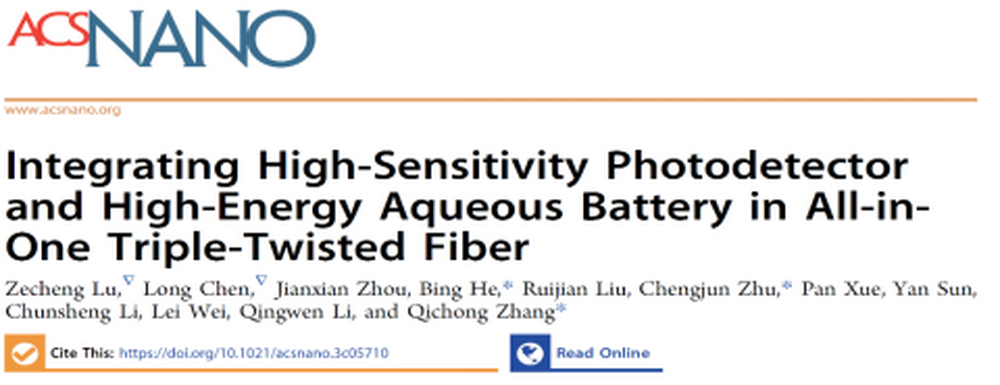
Flexible photodetectors that can invert light signals into electrical signals are gaining substantial interest in cutting-edge intelligent electronics applications, such as biomimetic eyes, environmental monitoring, smart textiles, and optical communications. Of particular interest are fiber-shaped photodetectors (FPDs), which possess excellent advantages, including high flexibility, a lightweight nature and omnidirectional light absorption, making them ideal for portable and wearable electronics. However, the practical application of traditional FPDs is severely limited by the irreversible degradation of performance caused by vulnerable interface compatibility on complex deformation and a single function. As a result, to design a new device structure is vitally important for construction of the practical application of FPDs which is excellently flexible, highly sensitive and multifunctional.
Here, a new integrated photoelectrochemical FPD/battery device (FPDB) is designed, consisting of a common electrode(K2Zn3(Fe(CN)6)2·9H2O@CNTF,ZnHCF@CNTF), photoanode(ZnO@CNTF), anode(NaTi2(PO4)3@CNTF,NTP@CNTF), and sol–gel electrolyte as an isolation layer, which not only effectively avoids the short circuit problem of FPD but also provides efficient ion transmission and endows high-efficiency energy storage capacity. As expected, the resulting all-in-one triple-twisted fiber-shaped FPDB simultaneously achieves high responsiveness and excellent volume capacity. Such a stable architectural design and multifunctional integration of functional fibers accelerate the development of next-generation wearable fabrics.
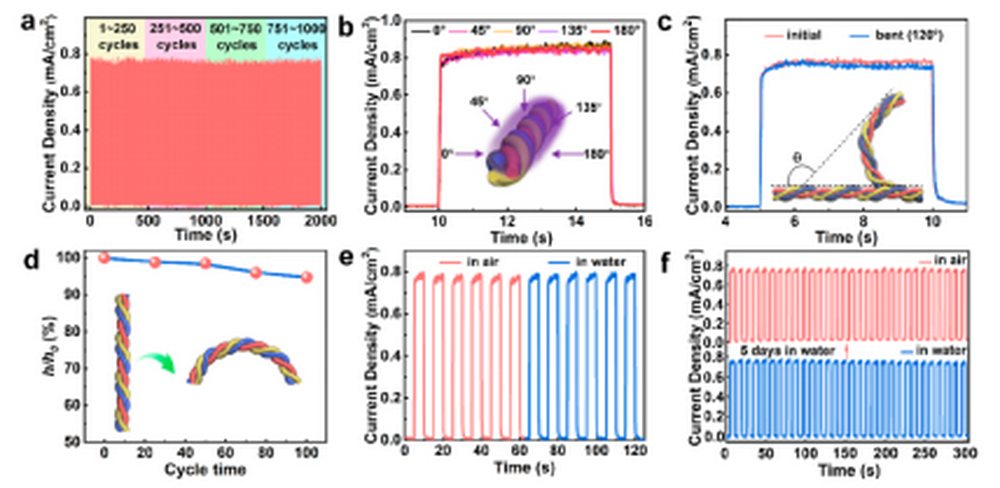
Fig.1 Mechanical flexibility and application of the FPD devices
For photodetection, the sol–gel electrolyte is the insulating layer that effectively encloses the electrodes and ensures optimal carrier transmission while also preventing short circuits between electrodes with a large area contact. In wearable applications, FPD shows favorable resistance to complicated physical deformation and excellent stability for optical signal delivery in wearable applications(With a bending angle of 120°, it maintains approximately 95.24% of the initial value after 100 bending cycles). In addition, the ZnHCF@CNTF counter electrode can accept large number of photogenerated electrons by taking advantage of its Na-ion storage performance, further improving carrier transmission efficiency. And the resulting FPD achieves a high responsivity of 151.45 mA W1–, a fast response time of 15 ms. Besides photodetection, the integrated device delivers a high discharge platform of 1.6 V and a volume capacity of 18.75 mAh cm–3.
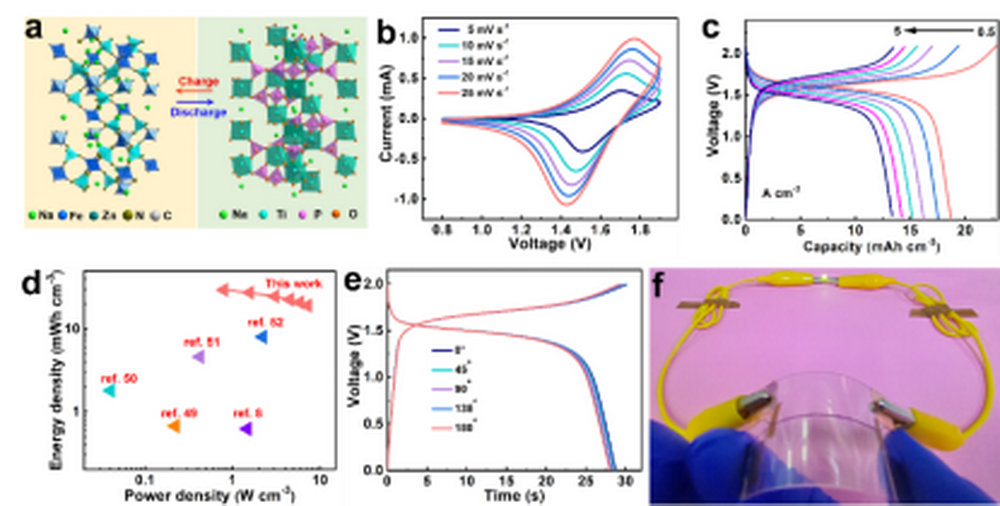
Fig. 2 Electrochemical performance
The research has been jointly completed by the research team of Prof. Zhu Chengjun of IMU and the research team of Research Fellow Zhang Qichong with Suzhou Institute of Nano-Tech and Nano Bionics of Chinese Academy of Sciences. Prof. Zhu Chengjun and Research Fellow Zhang Qichong are the corresponding authors of the article. The first author of the article is Lu Zecheng , a master student who is the member of the research team of Prof. Zhu Chengjun. And IMU is the institution the first author is with. This research is supported by the National Natural Science Foundation of China (Grant No. 62064010), the National Key R&D Program of China (2022YFA1203304) and the Natural Science Foundation of Jiangsu Province (BK20220288).
In addition, the research team of Prof. Zhu Chengjun has also made progress in the research on nickel oxide -based perovskite solar cells. The research result concerned has been published in the international top journal in physics-Applied Physics Letters. The result is titled “Triple hole transporting and passivation layers for efficient NiOX-based wide-bandgap perovskite solar cells”(URL of the article: https://pubs.aip.org/aip/apl/article/122/22/223903/2893945/Triple-hole-transporting-and-passivation-layers).
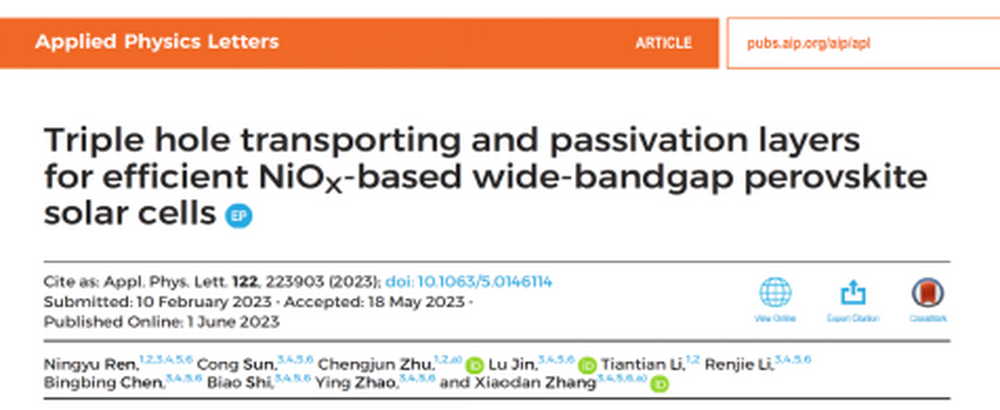
In order to fabricate nickel oxide (NiOX)-based perovskite solar cells with high efficiency and stability, adverse reaction and lattice mismatch are two urgent problems to be overcome. This work provides a simple and practical approach and designs a multifunctional strategy to fabricate compact hybrid HTLs through the multi-layer modification of NiOX and obtain high performance wide-bandgap PSCs by utilizing multi-layer bifunctional additive modification.
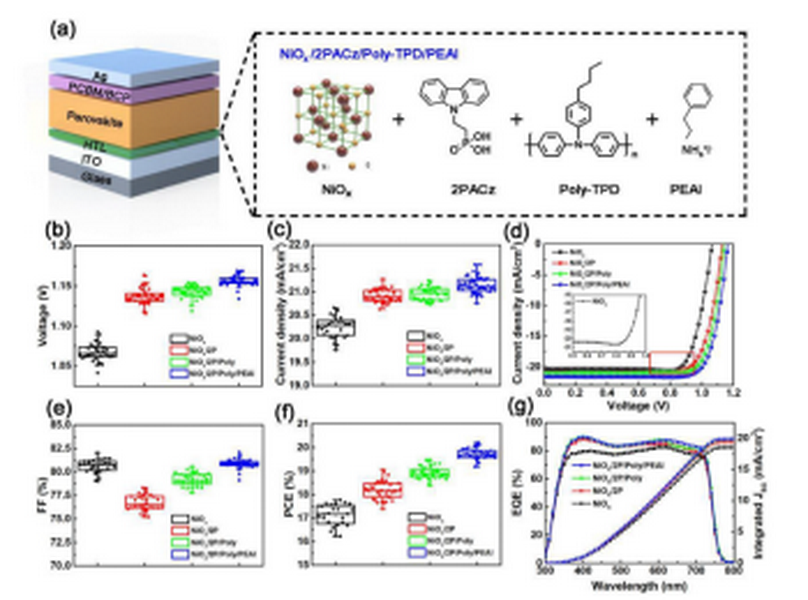
Fig. 1 (a) Schematic diagram of device structure of NiOX-based HTLs. (b-f) J-V curves of PSCs under AM 1.5 illumination. (g) IPCE spectra and integrated JSC under the AM 1.5 illumination
In this work, interface engineering was carried out by multi-layer passivation NiOX HTLs (NiOX/ 2PACz/Poly-TPD/PEAI) to provide optimized interface contact between NiOX and perovskite, ameliorate band alignment, and saturate the defect states. Application of 2PACz avoids direct contact of the hydroxyl groups (which causes degeneration of a device), improves conductivity, and reduces interfacial defects. The poly-TPD modification can provide an appropriate band alignment at the interface of NiOX/ perovskite. PEAI was used to modify the Poly-TPD surface, and its NH3 group can passivate unbonded Pb ions of perovskite. Thus, compared with previously reported single-function passivation materials, the article proposes the multilayer passivation that integrates multiple functions. As a result, compared to 17.37% of the reference device, the NiOX/2PACz/Poly-TPD/PEAI-based wide bandgap PSCs obtain a champion power conversion efficiency (PCE) of 20.21% and maintain over 95% of their initial PCE values after storage in a nitrogen atmosphere for 1000 h. This finding provides a practical approach for fabricating high-performance regular PSCs with NiOX-based HTLs. The multi-layer passivation strategy can synchronously reduce the defect states at NiOX and perovskite interfaces, improve the crystallinity and stability of the perovskite layer, provide a favorable band alignment, and promote the transport and extraction of carrier and supports their commercialization.
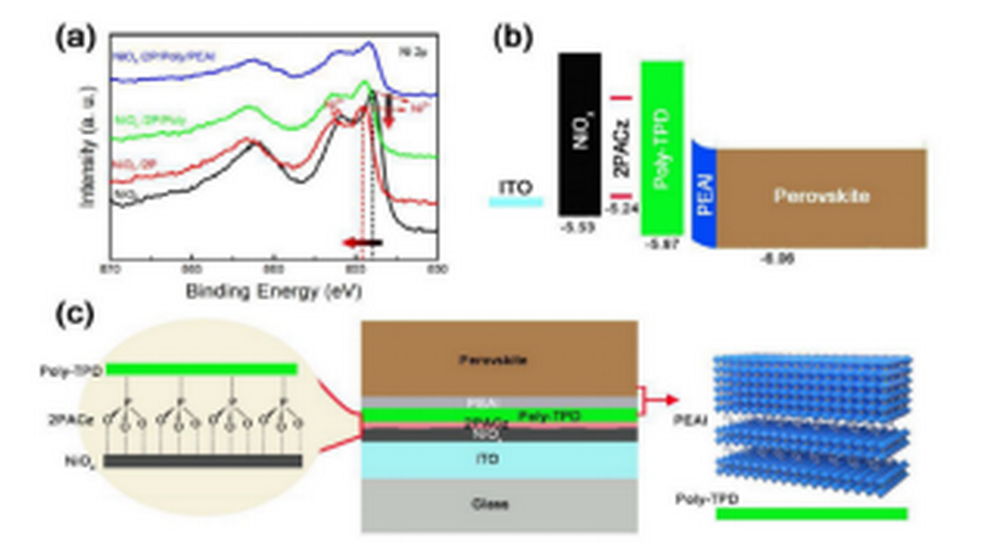
Fig. 2 (a) XPS measurement of Ni 2p3/2 for NiOX, NiOX/2P, NiOX/2PACz/2P/Poly, and NiOX/2PACz/2P/Poly/PEAI. (b) Schematic energy level diagram of NiOx and NiOX/ multi-layer passivation with perovskite. (c) Mechanical explanation of the multi-layer passivation HTLs.
The research has been jointly completed by the research team of Prof. Zhu Chengjun of IMU and the research team of Prof. Zhang Xiaodan with the Institute of Photoelectronic Thin Film Devices and Technology of Nankai University. Prof. Zhu Chengjun and Prof. Zhang Xiaodan are the corresponding authors. Ren Ningyu, PhD student of Prof. Zhu’s research team of IMU, is the first author of the article. And IMU is the institution the first author is with. The research is supported by the National Natural Science Foundation of China(Grant Numbers: 620641010, 11564027, 61674084) and the National Key Research and Development Program of China (Grant No. 2018YFB1500103).
Besides, the research team of Prof. Zhu Chengjun has also made important progress in the research of semiconductor heterostructure for the low temperature solid oxide fuel cells. The research result concerned has been published in the international top journal in engineering materials science-ACS Appl. Mater. Interfaces. The article is titled as “Novel n−i CeO2/a-Al2O3 Heterostructure Electrolyte Derived from the Insulator a‑Al2O3 for Fuel Cells”(URL of the article: http://pubs-acs-org-s.vpn.imu.edu.cn:8118/doi/epdf/10.1021/acsami.2c18240)

Heterostructure technologies have been regarded as the most promising method in the development of electrolytes with high ionic conductivity for low-temperature solid oxide fuel cells (LT-SOFCs). Here, a novel semiconductor/insulator (n−i) heterostructure strategy has been proposed to develop composite electrolytes for LT-SOFCs based on CeO2 and the insulator amorphous alumina (a-Al2O3). The constructed CeO2/a-Al2O3 electrolyte exhibits an ionic conductivity of up to 0.127 S cm−1 , and its fuel cell achieves a maximum power density (MPD) of 1017 mW cm−2 with an open-circuit voltage (OCV) of 1.14 V at 550 °C without the short-circuiting problem, suggesting that the introduction of a-Al2O3 can effectively suppress the electron conduction of CeO2.
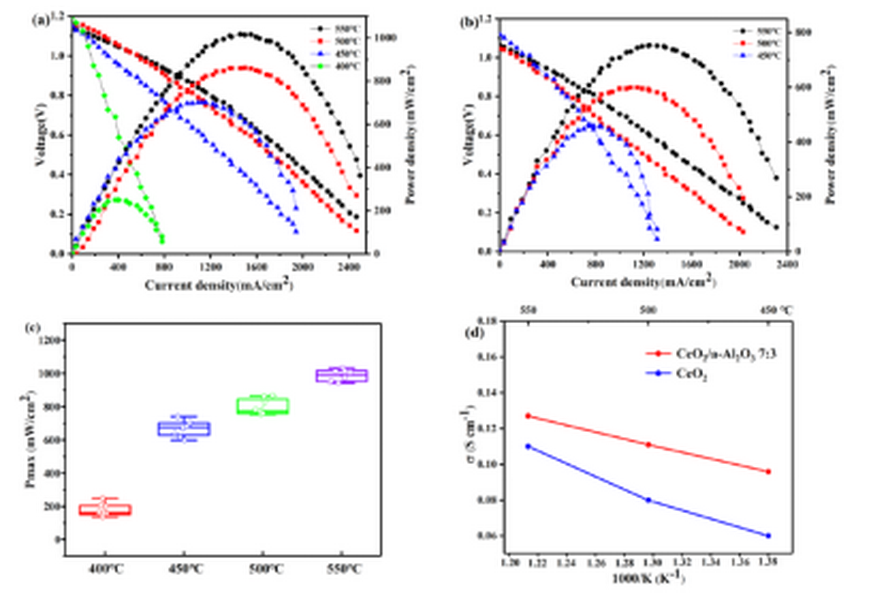
Fig. 1 IV−IP curves based on (a) CeO2/a-Al2O3 7:3 and (b) CeO2 electrolytes; (c) box plot with the statistics for the power maximum from eight separate cells measured at different temperatures and (d) Arrhenius plots for CeO2/a-Al2O3 7:3 and the pure CeO2 electrolyte.
Further investigation showed that on introducing a-Al2O3 into CeO2, microscale heterointerfaces were formed in the heterostructure composite. The interface analysis by high-resolution transmission electron microscopy (TEM) also confirmed the n−i heterostructure contact between CeO2 and a-Al2O3 phases. It is found that the potential energy barrier at the heterointerfaces caused by the ultrawide band gap of the insulator a-Al2O3 plays an important role in restraining electron conduction. Simultaneously, the thermoelectric effect of the insulator induces more oxygen vacancies because of interface charge compensation, which further promotes ionic transport and results in high ionic conductivity and fuel cell performance. This study presents a practical n−i heterostructure electrolyte design, and further research confirmed the advanced functionality of the CeO2/a-Al2O3 electrolyte. This study may open frontiers in the field of developing high-efficiency electrolytes of LT-SOFCs using insulating materials such as amorphous alumina.
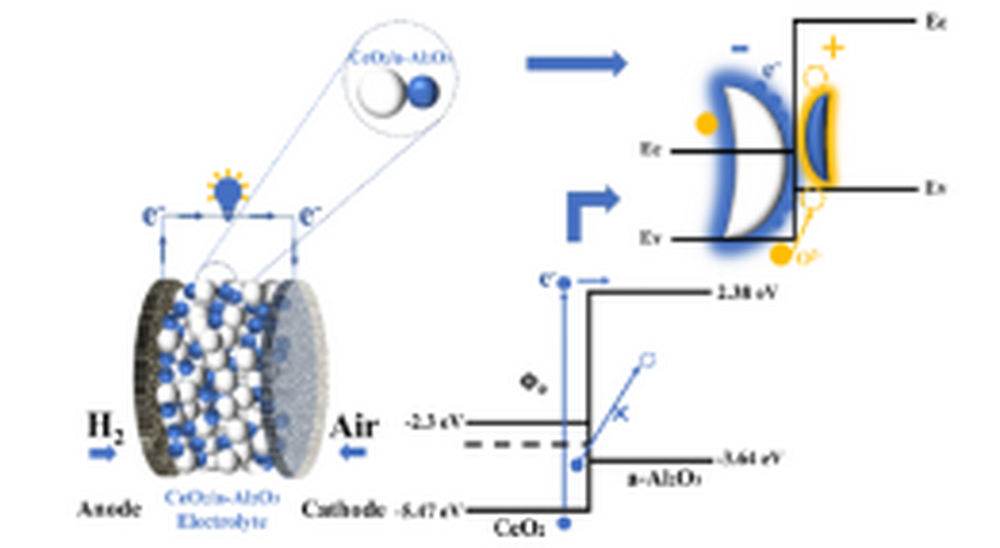
Figure. 2 (a) TEM and (b) HR-TEM images of CeO2/a-Al2O3 7:3 and schematic diagram of the band structure and potential energy barrier
The research has been completed by the research team of Prof. Zhu Chengjun. Prof. Zhu Chengjun is the corresponding author of the article and Zhang Yingbo and Zhu Decai, 2 PhD students of Zhu’s research team, are the co-first authors of the article. IMU is the institution the first authors are with. The research has been supported by the National Natural Science Foundation of China(Grant No. 620641010) and the Natural Science Foundation of Inner Mongolia Autonomous Region (Grant No. 2020MS05004).
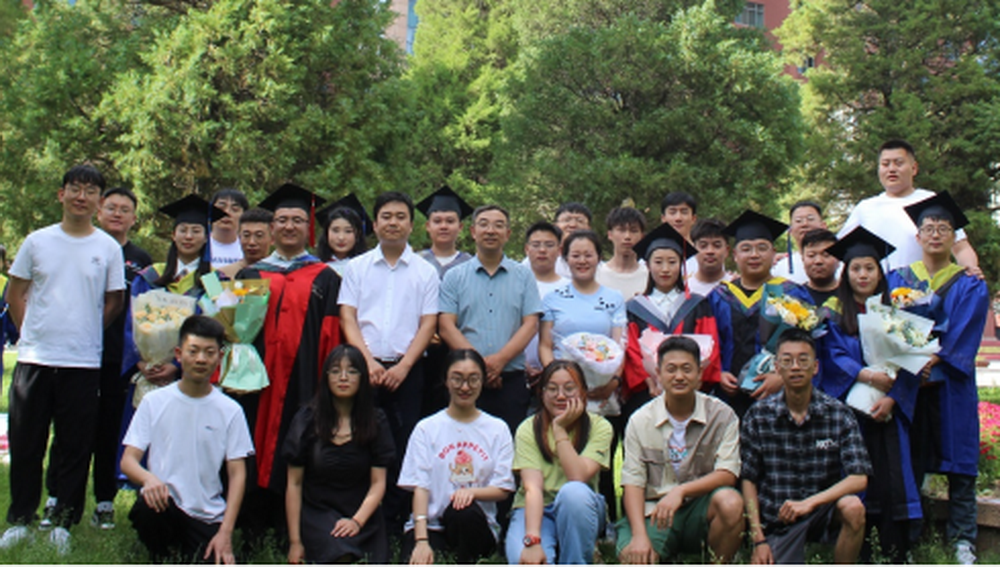
Prof. Zhu Chengjun’s research team
A brief introduction to the corresponding author: Prof. Zhu Chengjun is a PhD student supervisor who is with the School of Physical Science and Technology of IMU. He graduated from the College of Physics of Jilin University as a doctor in June, 2009. Since July, 2009, Zhu has been working at IMU. In recent years, he has been focusing on the research on the preparation of semiconductor photoelectric materials and fabrication of semiconductor photoelectric devices. He has led the research of 3 projects supported by the National Natural Science Foundation of China, 1 project supported by Inner Mongolia Program for Guiding the Scientific and Technological Innovation, 1 open project of the key laboratory of Inner Mongolia, 2 key projects of the key laboratory of Inner Mongolia, 1 important project supported by Inner Mongolia Natural Science Program for Universities, 1 project supported by Inner Mongolia Academy of Science and Technology Program for Guiding the Scientific and Technological Innovation, 2 projects supported by the Inner Mongolia Program for Key Research and Development and Achievement Transformation(cooperation between universities and enterprises) and 1 scientific and technological project of Inner Mongolia(cooperation between universities and enterprises). Prof. Zhu has published over 50 SCI articles in such international top journals as ACS Nano, Small, ACS Appl. Mater. Interfaces, Energy Storage Materials, Applied Physics Letters, Energy Conversion and Management, Applied Surface Science, J. Power Sources, ACS Appl. Energy Mater.. He has 1 authorized Chinese patent for invention. The graduation theses of 3 master students supervised by Zhu have been graded as the autonomous-region-level excellent graduation theses of master students.

